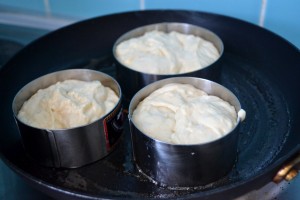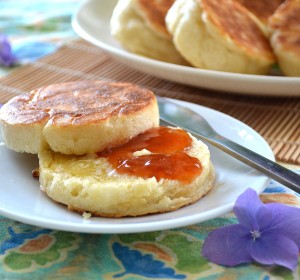 For as long as I can remember, I have been fascinated by the food people eat in books. Reading descriptions of food in fiction, I remember thoughts along the lines of “I want to eat that,” and, as I grew older, “I want to replicate that.” The food in Laura Ingalls Wilder’s books was especially captivating. At my parents’ house in the Catskills, not content to eat potatoes baked in the oven, I would put mine in the fireplace. “It’s really good,” I would insist, as I chipped away the black carbonized exterior to get at what remained of my potato. When I was about 12, I was given the Little House Cookbook. I tried to make maple candy by pouring barely-caramelized maple syrup on snow (like chewy brown Rorschach blots; not an improvement), ice cream without a churn, in a bowl of salted ice (disastrous), and “Johnny Cakes.” (I don’t remember much, except that they were virtually inedible.) Someone later explained to me that the reason why Ingalls Wilder so vividly described food, and why it all sounded so delicious, was because she spent most of her childhood hungry.
For as long as I can remember, I have been fascinated by the food people eat in books. Reading descriptions of food in fiction, I remember thoughts along the lines of “I want to eat that,” and, as I grew older, “I want to replicate that.” The food in Laura Ingalls Wilder’s books was especially captivating. At my parents’ house in the Catskills, not content to eat potatoes baked in the oven, I would put mine in the fireplace. “It’s really good,” I would insist, as I chipped away the black carbonized exterior to get at what remained of my potato. When I was about 12, I was given the Little House Cookbook. I tried to make maple candy by pouring barely-caramelized maple syrup on snow (like chewy brown Rorschach blots; not an improvement), ice cream without a churn, in a bowl of salted ice (disastrous), and “Johnny Cakes.” (I don’t remember much, except that they were virtually inedible.) Someone later explained to me that the reason why Ingalls Wilder so vividly described food, and why it all sounded so delicious, was because she spent most of her childhood hungry.
As a youthful Anglophile, I found English food especially intriguing. (No, really.) Everything was exotic. The English drank sweet, milky tea in the afternoon. (In my household, tea was served black and unsweetened, with babka, after dinner.) They had toast with butter and jam for breakfast! They ate flamed Christmas pudding with suet (I’d been reading a lot of Dickens), and Yorkshire pudding, whatever the heck that was. But the ne plus ultra of English cookery was the mysterious crumpet. I WANTED CRUMPETS. I wanted to make crumpets. Somewhere I found a recipe for crumpets and I made them. Again, and again, and again. My poor parents.
Last week,when I made fresh ricotta, I reserved my whey with the promise that it would be used in another recipe. My research disclosed that the best use for whey was in baking. Whey has a higher concentration of lactose than ordinary milk and its proteins act as a “flour conditioner.” (This website fully explains the food science behind using whey products when baking.) When deciding what to bake, for some reason – perhaps my self-congratulatory sense of frugality – my thought turned to crumpets. Crumpets are made with scalded milk, which made the substitution very straightforward. I couldn’t find the recipe I used to use as a child, so I adapted this one from the Southern Heritage Breads Cookbook. (Sorry, English people!) For some reason – perhaps the addition of eggs to the recipe – these crumpets don’t have the distinctive holes in their surface I’m used to, but they are light, buttery, and delicious. Hence, “Southern-style” in this recipe’s title.
You will Need:
A good non-stick skillet, seasoned griddle, or cast-iron pan
Four-inch muffin rings (You can use tuna tins from which the tops and bottoms have been removed)
Ingredients:
1 pkg yeast
50 g butter plus additional butter or shortening
¼ cup warm water
1 large egg
1 and ¾ cups whey (or scalded milk)
1 and ¾ cups all-purpose (plain) flour
1 tsp salt
Method:
Heat the water to about 105-115 degrees Fahrenheit (40-50 degrees Celsius) and combine with melted butter and yeast. Set aside for 15 minutes to allow yeast to bloom.
Heat the whey to the same temperature (if using scalded milk, allow to cool to this temperature) and beat in egg. Gradually beat in flour and salt. Mix together with yeast/water/butter mixture. You should have a thick batter. 
Cover and allow to rise until double in bulk, about an hour or an hour and 15 minutes. 
Grease muffin rings and heat skillet or griddle with a little of butter. Place muffin rings on hot skillet and scoop in some of the batter, filling to a depth of approximately ¾ inch, or two centimetres. Lower heat and cook for 8-10 minutes on each side, using a spatula to flip. The crumpets will puff satisfyingly. 
Cool on a wire rack, and serve warm or split and toasted with plenty of butter and jam. 
Makes about 12 crumpets.


Interesting, using whey instead of milk — I’ve never heard of that. Crumpets, to me, always sound better than they taste — it’s such a good word.
I love the word crumpet too. I think that’s why I was so fascinated by them.
I can’t tell you how excited I am to see this recipe. I’ve always wanted to make crumpets and these look delicious. My little Anglophile heart is pitter-pattering with excitement. And I too drizzled maple syrup on snow. It was gross.
I am not surprised to hear that you too were a Little House Cookbook early experimenter! I think I also tried to make the horehound candy, which was disgusting. These are less crumpet-like than the recipe I used to make as a child (oh where did I find it?!) but they are delicious nevertheless.
I too adore Laura Ingalls Wilder’s books. If nothing else the reader gets a strong appreciation for modern conveniences… like grocery stores. “The Long Winter” is absolutely stuck in my mind. Made me want to drop off a load of firewood and several bags of groceries at their place.
English food. I was served the most inedible paste, calling itself lasagna, at a pub in Loughborough. I know they’ve made great strides but that one is hard to forget. I also had the best pork chop of my life in Northumberland. How about jellied eels, Keddgeree, mulligatawny soup, kippers, the roasted goose from A Christmas Carol, spotted dick anyone?
Oh gosh, “The Long Winter” was harrowing!
“Kippers” confused me for a long time. And frankly “pudding” still confuses me. (Why call it pudding if it’s not pudding-y? Why are all desserts called puddings? I need to research the etymology of this term.)
Yay! I have been looking for things to make using Whey 🙂
http://www.myboulangerie.wordpress.com
Cool! Let me know if you come up with any other ideas.
I’ve never even contemplated the people of eat in books… perhaps I’ll give it more thought next time… These crumpets look perfect you know…
Praised on my crumpets by a bona fide Welshman! An honor! Thank you!
Haha really enjoyed this one. I was just like you. I was so fascinated by all these food mentioned in books, and since many books were written by English authors, they featured a lot of (to me) obscure English teatime treats which I only could imagine. The one that really got me was scones. They just sounded so good. You ate them with clotted cream (woahh what’s that? like ice cream?) and jam and it all sounded so posh and english and lovely. I haven’t tried makign them though, I resort to eating them in cafes. You’re a real inspiration for making your own crumpets (and for not giving up on them)! Nice tip using whey!
I felt exactly the same way about scones. And clotted cream, which I have to confess is still mysterious to me. Is clotted cream like butter when it’s still at the creamy stage? Yummmm. There are meals I remember — e.g., the tea served by the faun to Lucy in The Lion, The Witch, and the Wardrobe — far more clearly than I remember the book they came from.
Thanks for another great idea for using whey. ( I have been making Greek-style yogurt and the last step is to drain much of the whey.) Wonder if crumpets are good with Greek yogurt. . .
BTW, a book written by a true Little House addict: The Wilder Life by Wendy McClure.
Thank you for the rec, Janet! I’ll look it up. I am sure crumpets would be good with Greek yogurt.
Your last post got me to thinking about making cheese, nice to know that the whey can be put to good use. Crumpets sound like a much nicer option for utilizing whey rather that sitting on tuffet and eating them with curds. I mean, there might be spiders around!
This comment made me laugh!
I completely agree about desiring to taste the things eaten in books. I love English literature and have never had a crumpet. This looks like something I could handle but it would likely be easier to dash across the pond and get one in London.
And more fun, too. 😉
There really is something special when reading about food in books. I love English muffins and scones but have never had a crumpet.
Isn’t there? Reading about food in books is so intimate! Crumpets are delicious. They’ve got a dense texture and a slightly yeasty flavor. Worth trying sometime. 😉
Adam Gopnik has a chapter on recipes and food in novels in his book ‘The Table Comes First’. I knew you would like the book, if you would only send me your address.
hjn
Done and done.
What a delightful post! I managed to read it when I was Internet-deprived on vacation and it’s just as good the second time around. Love your memories of childhood cooking (how well I remember the youthful optimist’s “It’s really good!” despite all evidence to the contrary). And those crumpets look really, really great.
What a sweet comment, Michelle! I hope your internet-deprived vacation (the best kind in my opinion) was fantastic. Xx
What a fantastic post. I just can’t imagine looking at English food with such intrigue, but now that I think about it, we do have some stuff that rocks! I love reading about food too. I love watching scenes in films that center around food. On that note, I found it astonishing in the latest Bond film how there was no food featured at all. I don’t know where he get’s his energy from! Hopefully see you at Maltby St soon for a catch up x
I think you might have a typo in the measurements for whey/flour. There is too large a quantity of liquid ingredients to create a “thick batter” – mine looks like a loose pancake batter!
Oh no! I’m so sorry to hear it. I am pretty meticulous about my measurements but would need to retest the recipe to see where it went wrong. I’ll try to do that and get back to you.
Sorry I didn’t see this sooner. Since it’s a yeast-based recipe, adding a bit more flour until the consistency is correct wouldn’t affect the flavour. Let me know what you did.